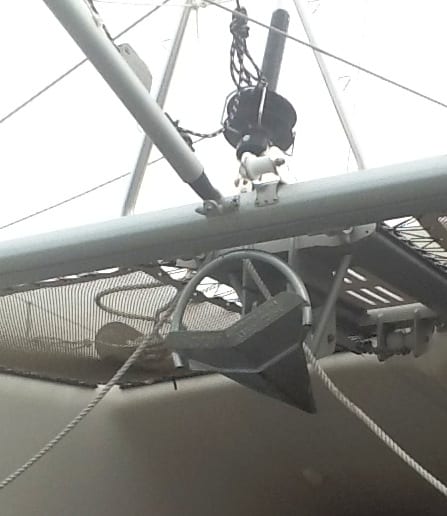The Best Anchoring Equipment For Your Catamaran
 Anchors for catamarans is a topic that has an opinion for every sailor you ask. And honestly, is no right or wrong answer. But I do know this: invest in the best anchor that you can afford. I am no anchor expert, but I have anchored enough times in my life across the globe in all kinds of conditions to know that a good anchor can be the difference between sleeping well at night or being up on anchor watch all night…or worse, losing the boat or a life because of a bad anchor.
Anchors for catamarans is a topic that has an opinion for every sailor you ask. And honestly, is no right or wrong answer. But I do know this: invest in the best anchor that you can afford. I am no anchor expert, but I have anchored enough times in my life across the globe in all kinds of conditions to know that a good anchor can be the difference between sleeping well at night or being up on anchor watch all night…or worse, losing the boat or a life because of a bad anchor.
Every catamaran owner has his/her personal reasons for choosing a particular type of anchor and anchor manufacturer. Ship chandlers and experts all have personal preferences and much advice. To figure out what you need, first figure out how an anchor works.
How An Anchor Works
Basically, anchors work one of in 2 ways
- they are either huge and heavy and use their weight to keep the boat from moving
- or, as in most modern anchor types, they are relatively light and bury themselves in the seabed to stop the boat from moving.
An anchor’s ability to create resistance is dependent on its ability to “hook” or “bury” itself into the seabed. It needs to create enough resistance in the seabed to withstand the environmental forces on the boat, i.e., wind and waves. Most modern anchors are very efficient. It’s their holding power, not necessarily their weight, that holds the boat in place although weight usually helps. Some anchors are now being made of aluminum and rely almost entirely on their shape for their function.
The next step is to find out what type and size anchor your boat’s manufacturer suggests for you particular boat. Use their recommendations together with your own research before you buy.
Choosing an Anchor for Your Catamaran
Make a decision based on what works on your boat, what type of sailing you will do, what type of bottom you are likely to encounter, etc. (Read this article: Independent Anchor Performance Testing). Boat weight and windage are but two factors to take into account when making a decision. Different weather conditions and the surface on which you will anchor, e.g., sand, mud, grass, rock and coral (not recommended for anchoring) may require different anchors and you may need more than one anchor to be used simultaneously in certain instances. Also find out what is recommended for the size of shackles, as well as length and size of chain and rode for your anchor and boat.
Ideally, an anchor should have the following characteristics:
- It should set quickly and reset when the wind/current shifts.
- It should have good holding in all bottom types: sand, mud, rocks, coral, and grass.
- It should be strong and of good quality—able to handle high loads on any part of its structure.
- Good holding power, even at short scope.
- Easy to release from the bottom without damage.
Stephen and I are firm believers in “the bigger, the better” when it comes to sizing anchors for our boat for bluewater cruising. Bigger anchors have more strength to resist breaking, occupy more of a surface area in the seabed to resist pullout, and have more weight to penetrate deeper. Physical size, rather than weight, is actually a better indicator of the anchor’s holding ability. (Some anchors that only weigh 5lbs. can hold in excess of 1,000 pounds!). We have doubled the size recommended for our boats and, believe me, we have needed it a time or two in stormy weather in a less than perfect anchorage and once when our engine failed on a lee shore.
 However, no single anchor possesses all of these attributes, but certain anchors represent a good balance for given conditions. We have just changed our Delta (Wing) anchor during haulout to a New Zealand Rocna as primary anchor. The Delta, even though generally a good anchor and is supposed to have good holding ability in varying bottom conditions, it does not excel in any one bottom. It has been hard to set and we have drifted several times even though the anchor is oversized (recommended for bigger boats). We have had problems with this anchor from day one, so we decided that the prudent thing to do was to change. One has to have faith in your anchor!
However, no single anchor possesses all of these attributes, but certain anchors represent a good balance for given conditions. We have just changed our Delta (Wing) anchor during haulout to a New Zealand Rocna as primary anchor. The Delta, even though generally a good anchor and is supposed to have good holding ability in varying bottom conditions, it does not excel in any one bottom. It has been hard to set and we have drifted several times even though the anchor is oversized (recommended for bigger boats). We have had problems with this anchor from day one, so we decided that the prudent thing to do was to change. One has to have faith in your anchor!
The new generation New Zealand Rocna anchor is designed to set quickly and create high holding power. It has a roll bar at the back which is supposed to ensure the anchor does not land on its back when trying to set it. The roll-bar and skids at the top corners of the fluke ensure the point is always ready to dig in after the anchor hits the bottom. There is no hinge or other moving parts to jam or foul. And if the boat swings and changes the angle of the anchor rode, the Rocna is continually self-resetting. It is rather expensive, but by all accounts, a great anchor. We have had only good experiences with the Rocna on several other boats in various weather conditions and different types of bottoms and we are suitably impressed.
We also have secondary anchors like a Bruce (Claw) and Danforth (Fluke), all for different applications and, of course, for hurricane anchoring if needed. The main selling point of the Bruce (Claw) is that it is an excellent all-round anchor. It will hold well in most bottoms, although it performs less well in sand and mud. It also has a low holding power to weight ratio, meaning you’ll likely require a heavier Claw anchor than you would require for other styles of anchor. It is heavy and awkward and we use it as a last resort.
The Danforth (Fluke) anchor performs quite well in mud and sand. The downside is that outside of mud and sand, the Fluke has very limited holding ability in bottoms such as kelp, rock, coral, etc. When being set in mud or sand, these anchors do have a reputation for occasionally dragging along the bottom.
Conclusion: When dealing with something that could possibly save your life, don’t pinch pennies. Buy the best anchor that you can afford and when choosing an anchor, make sure to be on the lookout for spotty galvanizing, poor welds, and other noticeable inconsistencies in the metal. It goes without saying that buying a cheap or inferior anchor will usually only turn to misfortune. Remember…you often get what you pay for so be sure not to buy a cheaper copy. In my opinion, a good anchor is a cheap insurance policy and Stephen and I practice what we preach by investing time and money in our anchoring system.
Read our article: How to anchor a catamaran.
Sail With Us to Learn


Week-Long Liveaboard Courses
Rare RYA Classes & Certifications
Catamaran Guru’s real-life practical methods combined with up-to-date sailing theory in lessons aboard recent model catamarans…or your own boat!
Prepare for certifications or take the first step aboard to embark on your dream life of boat ownership or cruising
Classes in S Florida and the Bahamas.





